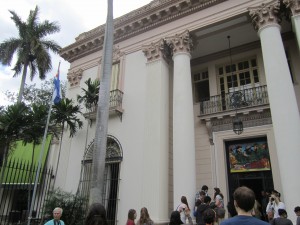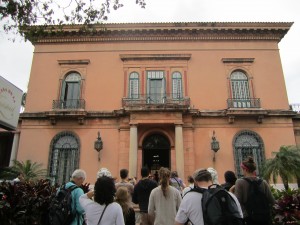The Reappropriation of Space in Havana
May 4, 2012 by kaadrian
Driving around Havana, one is struck by the beauty of the huge houses that still stand. Many on the Malecón are in are complete disrepair after decades of being beaten by the waves flying up from the ocean day after day.
Others are falling in on themselves – and tragically sometimes their inhabitants – from a simple lack of funds to maintain them. Still others are perfectly preserved with relatively fresh coats of paint. As one moves west from the neighborhoods of Vedado to Miramar to Sibonay, in Havana, the well-preserved mansions only appear more frequently and are often larger. Are these lavish homes the residences of Cuba’s top politicians and the of those lucky people who have managed to become wealthy in a country where everyone is supposed to have an equal share of not very much?
Surprisingly, or perhaps not so surprisingly, no.
Of course, those with more money (specifically access to foreign money) do finagle their ways into better living spaces but that is not what the houses that used to be symbols of the United States’ dominance is used for. In Vedado, we visited two lavish homes built by non-Cubans that have since been re appropriated for usage by the Cuban state.
The first was the Instituto Cubano de Amistad con los Pueblos (ICAP) house.
As you can see, the house is amazing. I haven’t the faintest idea why I don’t have pictures from the inside but it was equally beautiful with, if memory serves, lovely marble and much of the original furniture and fixtures. The back had a wrap-around porch which was shaded by the green awning you can see in the picture above that looked out on a garden that I imagine was once much bigger and better maintained. This was the kind of place that was owned by the men who made Cuba a playground, who caused Havana to be flooded with prostitutes and casinos. This wasn’t even the most expensive and lavish house we visited in Havana.
The house has come a long way from its original usage. ICAP’s main mission is to connect with nations and private groups around the world who stand in solidarity with the Cuban government. They also seek to end what the propaganda the United States disseminates against Cuba. When we met with a representative of ICAP on the covered porch, we got our first taste of the difficulties we would come up against when trying to communicate with members of the Cuban government. Our host, although lovely, stuck very much to her party line. I remember a certain defensiveness and evasiveness in the answers to many of the questions we asked. It makes sense though. For one thing, ICAP does a lot to combat the damage that the United States does to Cuba in the international community today. For another, it is located in a building that is highly representative of all of the disrespect with which people from the United States used to do to their gorgeous country; we came in, built luxurious homes and treated Cubans as though they were inconsequential. Later on, we would also met with representatives of CENESEX, Cuba’s sexual health and education department. To me, the usage of this space for purposes so important to the Cuban people is just so wonderful.
Another example of space reappropriation is the Casa de la Amistad.
Our tour guide, Yoel, told us the love story that created this place which I believe took place in the late 19th century. A man and a young woman fell in love but she was already married so they fled to Spain since divorce was illegal in Cuba at the time. When it became legalized, they returned and built this mansion to live in finally as man and wife. Yoel listed all the things that were imported to decorate their home such as marble from Italy. It was one of the most expensive houses ever erected in Havana. Yoel said that not a thing in the house was from Cuba which was fitting. Today, the house has a restaurant with live entertainment some nights. It also houses Yoel’s tour company, Amistur. One could of course argue – and many do – that pandering to tourists is just a a new and different way that Cubans are being exploited by foreigners but I believe it is different because of the level of control the Cuban government has in these interactions.
The western neighborhood of Siboney is home to the last built mansions of the non-Cubans; it was the posh neighborhood when the revolution triumphed. Now, they house international consulates and embassies. Yoel’s rationale for why the Cuban government did not turn these mansions into multi-family housing in that this neighborhood was not built for or by Cubans so it does not have the schools or stores Cubans need. I find this to be a weak explanation; these are things that could be built. But I suppose when the country has almost no money, it makes some sense.
The fact that the breathtaking mansions are not inhabited by Fidel and Raul Castro and their family members is telling. It shows one of the reasons why the Cuban people are faithful to their revolution through all the challenges they face on a day-to-day basis. Because Fidel has never lived high on the hog like many dictators do, the people are able to feel that he is truly with them. Because the government gives over these speaces that are so representative of the Cuban peoples’ former oppression by outside forces, the idea that they live in a just society seems slightly less difficult to argue with. It is a brilliant move to keep up appearances but I tend to believe it is also more than that. The Cuban Revolution was so much about taking their country for them. The reappropriation of space in Havana is continuing that work in a very visible way.
Leave a Reply
You must be logged in to post a comment.



